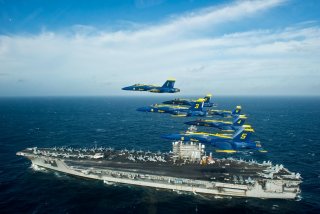Aircraft Carriers Fear Two Things More Than Anything Else (Not Russia or China)
In the 1960s, the Navy also suffered a series of deadly accidents aboard its carriers.
Lesson Learned?
Unlike the Oriskany fire, the Navy did not hold any individuals legally culpable, though Captain Beling was reassigned to administrative duties. It seems clear, however, that the decision to cut corners and employ unstable bombs and prematurely armed rockets in order to meet the high operational tempo expected by the Pentagon led to dozens of deaths.
The Forrestal fire did lead to major reforms of the Navy’s firefighting procedures, including better training in damage control for the crew at large. In the next two years, new firefighting devices that could flood the entire carrier deck with flame-retardant foam were installed. A Farrier Firefighting School was opened at Norfolk, named after the chief who sacrificed his life attempting to douse the first bomb.
Unfortunately, just six months later, history would repeat itself, and yet another prematurely fired Zuni rocket would trigger a deadly blaze on the USS Enterprise.
Sébastien Roblin holds a master’s degree in conflict resolution from Georgetown University and served as a university instructor for the Peace Corps in China. He has also worked in education, editing and refugee resettlement in France and the United States. He currently writes on security and military history for War Is Boring.
Image: Flickr.

